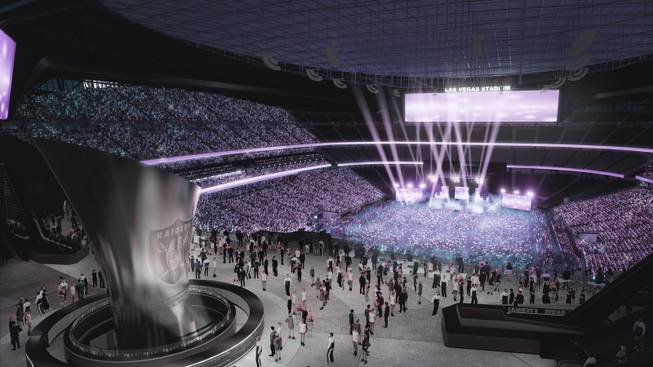
Courtesy
Raiders Las Vegas Stadium Peristyle End Stage Rendering
Thursday, Sept. 13, 2018 | 2 a.m.
Related news
Las Vegas is well regarded for successfully hosting marquee events, everything from championship fights and the NBA Summer League, to the Miss Universe Pageant and other entertainment events on the Strip.
So what would it take to bring large-scale sporting events like the Super Bowl, Final Four and the College Football Playoff to the new Las Vegas stadium?
The requirements to host the Super Bowl and other big events at the $1.8 billion, 65,000-seat venue was a focal point of Wednesday’s meeting of the Southern Nevada Sports Events Committee.
As the panel of experts went through the bevy of requirements, Las Vegas seemed to be an ideal city to land a major event once the stadium opens in 2020. Take the Super Bowl, for instance.
The group said requirements for the NFL championship include: Stadium capacity of 70,000 fans (the stadium can expand to that); climate controlled stadium if average temperature falls below 50 degrees; modern stadium amenities; hotels equal to 35 percent of stadium capacity within an hour drive; cost-free use of stadium, parking (35,000 spaces) and complete control of all structures on stadium grounds for 54 days (30 days before Super Bowl, 24 days after).
Additionally, the host city would need to be able to accommodate ancillary events, including: Super Bowl Boulevard, the NFL Experience (750,000 visitors over 10 days), a 400,000-square-foot space for NFL Tailgate Party, among others. Las Vegas would first be able to host the Super Bowl in 2025.
Utilizing partnerships with major resorts would be key in Las Vegas’ potential bid, said panelist Adam Kerns, director of Conventions, Sports and Leisure International. He addressed the 19-member committee put together by Gov. Brian Sandoval.
“Aligning yourself with various casino operators for events or creating special things around some of the properties on the Strip and utilizing some of those relationships to enhance the value for the participants,” Kerns said. “Whether it be the hosts of the events and treating to the best the city has to offer.”
Aside from facilities, ease of travel to and from the destination, the city’s experience in hosting large events, availability of event space and the attractiveness of the destination were noted as key elements in Las Vegas’ favor.
The lack of parking at the stadium, with a little over 2,700 spaces on site, and around 12,000 spaces offsite, wouldn’t deter the NFL from bringing the “big game” to Las Vegas, said Brian McCarthy, an NFL spokesperson.
A lack of parking didn’t hinder Minnesota from hosting the 2018 Super Bowl. Its new US Bank Stadium has less than 300 on-site parking spots, according to the Raiders parking study. In Atlanta, which will host the 2019 Super Bowl, there’s just 2,382 on-site spots.
“It has not been an issue when owners consider where upcoming Super Bowls will be played,” McCarthy said. “A lot of these fans will be coming from out of town, and will not necessarily have a vehicle to park and the many different groups coming in generally arrive by public transportation, or walk.”
Although specifically not addressing Las Vegas, McCarthy said the amount of hotel and event space within a stadium’s vicinity is a plus.
“Certainly, hotel space and then venue space do play into what event planners look for in big events,” he said.
The Las Vegas Valley has almost 150,000 hotel rooms, according to the Las Vegas Convention and Visitors Authority, and millions of square feet of event space within driving distance of the stadium.
The host committee’s budget to bring a Super Bowl to Las Vegas could be $40 million to $60 million, said panelist Frank Supovitz, a former NFL employee who helped write Super Bowl bid packages. The NFL would control most of the revenue from the event — ticket sales, concessions, merchandise, etc.
Yet, the upfront cost is well worth it — Minnesota reportedly made $300 million last year, not to mention the enormous week of free advertising for the city.
It welcomed 125,000 visitors, each of whom spent $625 per day on food and entertainment.
“The economic impacts associated with these sorts of events is significant,” Kerns said. “It generates incremental visitors to come to the area … we’ve studied it, we’ve surveyed it, and they have a positive impact on the community.”
